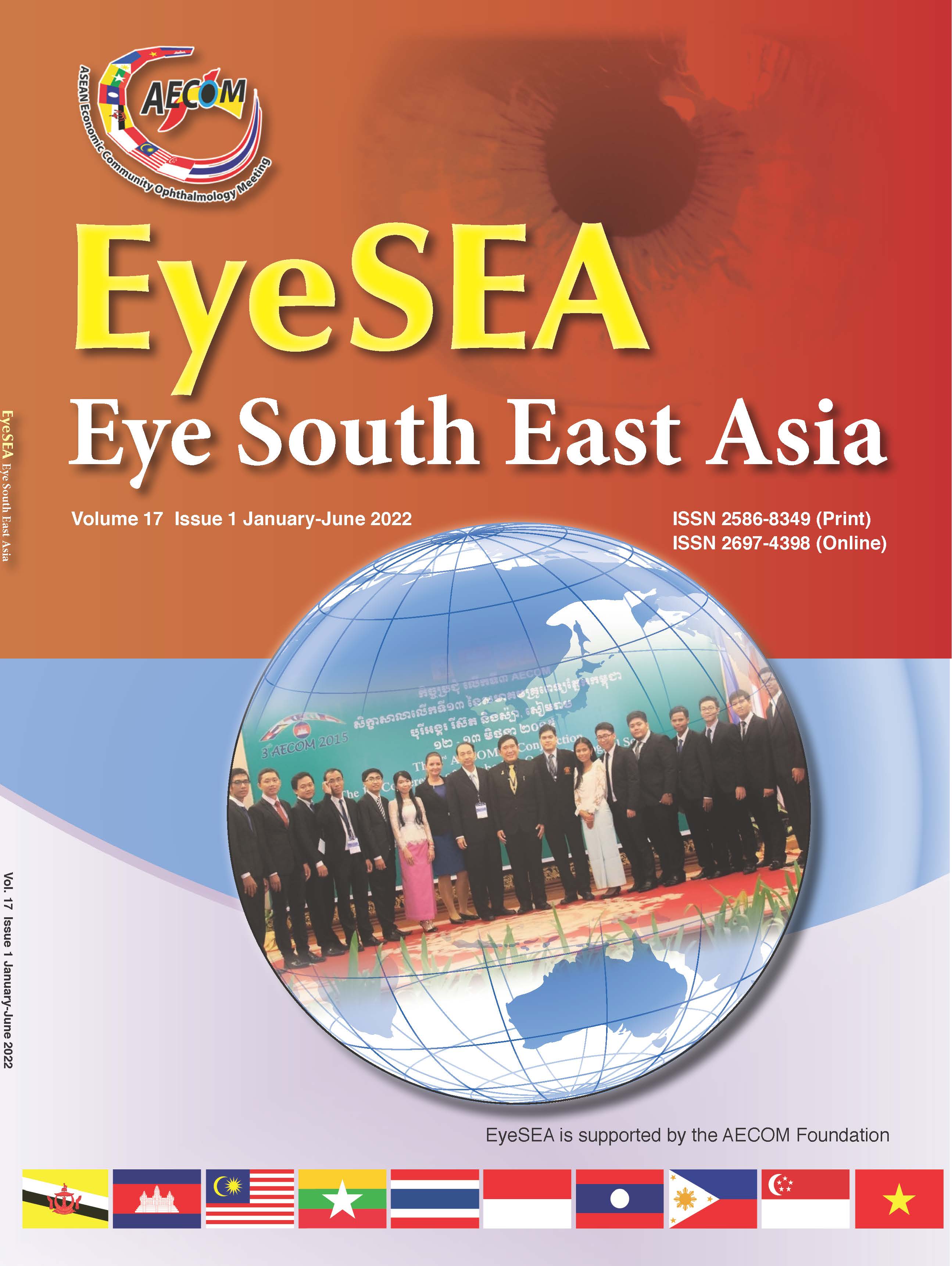Prognostic Factors for Recurrence of Macula Edema in Central Retinal Vein Occlusions after Intravitreal Anti-VEGF Injections: A Comparative Study
Main Article Content
Abstract
Purpose: To examine the prognostic factors for recurrence of macula edema in central retinal vein occlusions (CRVO) after anti-vascular endothelial growth factor treatment (anti-VEGF).
Methods: A retrospective study of 116 patients with CRVO treated with at least 3 intravitreal injections of anti-VEGF at a tertiary care hospital. Age, gender, fasting blood sugar, blood pressure, visual acuity, fundus image and OCT macula was collected for each patient.
The data was descriptively and comparatively analyzed using Chi-square test, independent t-test and Mann-Whitney U-test.
Results: Of the 116 patients enrolled, 2 groups of 58 patients had recurrent and nonrecurrent macula edema after treatment with at least 3 intravitreal anti-VEGF injections for CRVO respectively. The mean age was 59.94 ± 12.50 for both groups, hyper-reflective
foci was more common in the recurrent group 44.8% vs 22.4% (P = 0.011), Triglycerides (115.12 ± 33.73 vs 94.25 ± 29.99, P = 0.011) and HbA1c (7.38 ± 1.02 vs 6.64 ± 1.36, P = 0.007) were found to be higher in the recurrent group. Central subfield thickness was
found to be thicker in the recurrent group (460.60 ± 76.51 vs 445.60 ± 111.30, P = 0.073).
Conclusion: Patients with CRVO and recurrent macula edema are associated with hyper reflective foci, higher levels of triglycerides and HbA1c. These findings can be helpful in prognosticating recurrence of macula edema in these patients.
Article Details

This work is licensed under a Creative Commons Attribution-NonCommercial-NoDerivatives 4.0 International License.
References
Cugati S, Wang JJ, Rochtchina E, Mitchell P. Ten-year incidence of retinal vein occlusion in an older population: the Blue Mountains Eye Study. Arch Ophthalmol 2006;124(5):726-32.
Fiebai B, Ejimadu CS, Komolafe RD. Incidence and risk factors for retinal vein occlusion at the University of Port Harcourt Teaching Hospital, Port Harcourt, Nigeria. Niger J Clin Pract 2014;17(4):462-6.
Karia N. Retinal vein occlusion: pathophysiology and treatment options. Clin Ophthalmol 2010;4:809-16.
Prisco D, Marcucci R. Retinal vein thrombosis: risk factors, pathogenesis and therapeutic approach. Pathophysiol Haemost Thromb 2002;32(5-6):308-11.
Ha y reh SS , Zimme rman MB , Podhajsky P. Incidence of various types of retinal vein occlusion and their recurrence and demographic characteristics. Am J Ophthalmol 1994;117(4):429-41.
David R, Zangwill L, Badarna M, Yassur Y. Epidemiology of retinal vein occlusion and its association with glaucoma and increased intraocular pressure. Ophthalmologica 1988;197 (2):69-74.
Appiah AP, Greenidge KC. Factors associated with retinal-vein occlusion in Hispanics. Ann Ophthalmol 1987; 19(8):307-9.
Bertelsen M, Linneberg A, Rosenberg T, Christoffersen N, Vorum H, Gade E, et al. Comorbidity in patients with branch retinal vein occlusion: casecontrol study. BMJ 2012;345:7885.
Rehak J, Rehak M. Branch retinal vein occlusion: pathogenesis, visual prognosis, and treatment modalities. Curr Eye Res 2008;33(2):111-31.
Yasuda M, Kiyohara Y, Arakawa S, Hata Y, Yonemoto K, Doi Y, et al. Prevalence and systemic risk factors for retinal vein occlusion in a general Japanese population: the Hisayama study. Invest Ophthalmol Vis Sci 2010;51(6):3205-9.
Shrestha RK, Shrestha JK, Koirala S, Shah DN. Association of systemic diseases with retinal vein occlusive disease. JNMA J Nepal Med Assoc 2006;45(162):244-8.
Baseline and early natural history report. The Central Vein Occlusion Study. Arch Ophthalmol 1993;111(8):1087-95.
Brown DM, Campochiaro PA, Singh RP, Li Z, Gray S, Saroj N, et al. Ranibizumab for macular edema following cen t ral re tinal vein
occlusion: six-month primary end point results of a phase III study. Ophthalmology 2010;117(6):1124-33.
Campochiaro PA, Brown DM, Awh CC, Lee SY, Gray S, Saroj N, et al. Sustained benefits from ranibizumab for macular edema following central retinal vein occlusion: twelve-month outcomes of a phase III study. Ophthalmology 2011;118(10):2041-9.
Heier JS, Campochiaro PA, Yau L, Li Z, Saroj N, Rubio RG, et al. Ranibizumab for macular edema due to retinal vein occlusions: long-term follow-up in the HORIZON trial. Ophthalmology 2012;119(4):802-9.
Dodson PM , Kritziner EE. Underlying medical conditions in young patients and ethnic differences in retinal vein occlusion. Trans
Ophthalmol Soc U K 1985;104 (Pt 2):114-9.
Dirani A, Mantel I, Ambresin A. Recurrent Macular Edema in Central Retinal Vein Occlusion Treated with Intravitreal Ranibizumab using a Modified Treat and Extend Regimen. Klin Monbl Augenheilkd 2015;232(4):538-41.
Elman MJ, Bhatt AK, Quinlan PM, Enger C. The risk for systemic vascular diseases and mortality in patients with central retinal vein occlusion. Ophthalmology 1990;97(11):1543-8.
Bolz M, Schmidt-Erfurth U, Deak G, Mylonas G, Kriechbaum K, Scholda C. Optical coherence tomographic hyperreflective foci: a morphologic sign of lipid extravasation in diabetic macular edema. Ophthalmology 2009; 116(5):914-20.
Prilck IA , Robertson DM, Hollenhorst RW. Long-term followup of occlusion of the central retinal vein in young adults. Am J Ophthalmol 1980;90(2):190-202.
Glace t-Be rna rd A , Co sca s G , Chabanel A, Zourdani A, Lelong F, Samama MM. Prognostic factors for retinal vein occlusion: prospective study of 175 cases. Ophthalmology 1996 103(4):551-60.
Rath EZ, Frank RN, Shin DH, Kim C. Risk factors for retinal vein occlusions. A case-control study. Ophthalmology 1992;99(4):509-14.
Gregori NZ, Feuer W, Rosenfeld PJ. Novel method for analyzing snellen visual acuity measurements. Retina 2010;30(7):1046-50.
Mitry D, Bunce C, Charteris D. Anti-vascular endothelial growth factor for macular oedema secondary to branch retinal vein occlusion. Cochrane Database Syst Rev 2013(1): Cd009510.


